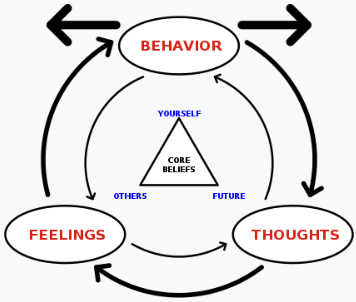Cognitive behavioral therapy (CBT) is a form of psychological treatment that aims to modify negative patterns of thought and behavior. It is based on the idea that our thoughts, feelings, and behaviors are interconnected, and that by changing negative patterns of thought, we can change our behaviors and ultimately improve our emotional well-being. It also focuses on a person’s values and core beliefs.
Some of the benefits of cognitive behavioral therapy include:
- It can help to reduce symptoms of depression and anxiety.
- It can help people to better manage stress and improve their coping skills.
- It can improve self-esteem and self-confidence.
- It can help people to develop healthier and more positive ways of thinking and behaving.
- It can help people to improve their relationships and communication skills.
CBT is usually delivered through a series of sessions with a trained therapist, either individually or in a group setting. The therapy typically involves identifying negative patterns of thought and behavior, and then working to modify them through techniques such as:
- Challenging and replacing negative thoughts with more realistic and positive ones
- Gradually exposing oneself to things that are feared or avoided
- Learning to relax and manage stress
- Setting achievable goals and working towards them
CBT is a collaborative treatment between the therapist and patient and typically (although not always) includes the use of Action Plans. An Action Plan is a series of steps that a person can take to address a specific problem or goal. It is an important part of the CBT process, as it helps to give people a sense of control over their thoughts and behaviors, and helps them to work towards positive change.
An Action Plan typically includes:
- A specific, measurable, achievable, relevant, and time-bound goal. This is something that the person wants to work towards, and it should be something that is realistic and achievable.
- A list of steps or tasks that the person needs to take in order to achieve their goal. These may include things like practicing relaxation techniques, setting aside time for self-care, or seeking social support.
- A timeline for completing each step or task. This helps to keep the person accountable, on track, and ensures that they are making progress towards their goal.
- Strategies for managing setbacks or obstacles. It is normal for people to encounter obstacles or setbacks when working towards a goal, and it is important to have a plan in place for dealing with these.
In short, an Action Plan helps to provide structure and guidance as a person works towards their goal in CBT, and can be an important tool for helping them to make lasting change.
Overall, CBT can be a very effective treatment for a variety of mental health issues, and has been found to be particularly useful for treating anxiety and depression.
To learn more, please visit: https://www.psychologytoday.com/us/basics/cognitive-behavioral-therapy?amp.









